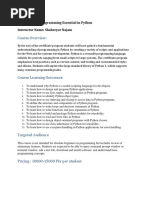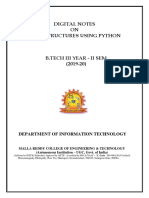0 ratings0% found this document useful (0 votes)
12 viewsPython Programming - Class Notes
This document contains class notes for a Python programming course, covering key topics such as the introduction to Python, basic syntax, control structures, functions, and data structures. It highlights Python's applications in web development, data science, automation, and AI/ML. The notes emphasize Python's simplicity and versatility as a significant programming language.
Uploaded by
mohammedshadhath7Copyright
© © All Rights Reserved
We take content rights seriously. If you suspect this is your content, claim it here.
Available Formats
Download as TXT, PDF, TXT or read online on Scribd
0 ratings0% found this document useful (0 votes)
12 viewsPython Programming - Class Notes
This document contains class notes for a Python programming course, covering key topics such as the introduction to Python, basic syntax, control structures, functions, and data structures. It highlights Python's applications in web development, data science, automation, and AI/ML. The notes emphasize Python's simplicity and versatility as a significant programming language.
Uploaded by
mohammedshadhath7Copyright
© © All Rights Reserved
We take content rights seriously. If you suspect this is your content, claim it here.
Available Formats
Download as TXT, PDF, TXT or read online on Scribd
You are on page 1/ 1
Python Programming - Class Notes
Course: Programming with Python
Semester: 2
Instructor: Prof. Shalini K
-----------------------------------------
Chapter 1: Introduction
Python is a high-level, interpreted language with dynamic typing and garbage
collection.
Applications:
- Web Development
- Data Science
- Automation
- AI/ML
-----------------------------------------
Chapter 2: Basics
- Variables and Data Types: int, float, str, list, dict
- Input/Output: input(), print()
- Operators: Arithmetic, Logical, Relational
-----------------------------------------
Chapter 3: Control Structures
- if, elif, else
- for loops
- while loops
- break, continue
-----------------------------------------
Chapter 4: Functions
- def keyword
- Parameters and return values
- Lambda functions
- Scope: local and global
-----------------------------------------
Chapter 5: Data Structures
- Lists: append(), pop()
- Tuples: immutable
- Dictionaries: key-value pairs
- Sets: unique values
-----------------------------------------
Conclusion
Python’s simplicity and versatility make it one of the most important languages in
the tech world today.
Prepared by: Mohammed Shadhath
"""
You might also like
- Instant Access to (eBook PDF) Building Python Programs 1st Edition ebook Full Chapters100% (2)Instant Access to (eBook PDF) Building Python Programs 1st Edition ebook Full Chapters41 pages
- Rick Sekuloski - PYTHON - Master Python OOP Programming With One Guide Only! A Lot of Coding, Practice and Theory Learn Python With Hands-On Projects (2022)No ratings yetRick Sekuloski - PYTHON - Master Python OOP Programming With One Guide Only! A Lot of Coding, Practice and Theory Learn Python With Hands-On Projects (2022)517 pages
- Program Name: B.Tech Semester:6TH Course Name: Course Code: Facilitator Name:ANTIM PANGHALNo ratings yetProgram Name: B.Tech Semester:6TH Course Name: Course Code: Facilitator Name:ANTIM PANGHAL13 pages
- AD-141 Introduction To Python Programming: Duration: 4 DaysNo ratings yetAD-141 Introduction To Python Programming: Duration: 4 Days3 pages
- Course Overview:: Course Name: Programming Essential in Python Instructor Name: Shaheryar NajamNo ratings yetCourse Overview:: Course Name: Programming Essential in Python Instructor Name: Shaheryar Najam3 pages
- ?_Master_Python_From_Basics_to_AI_&_Machine_Learning_?No ratings yet?_Master_Python_From_Basics_to_AI_&_Machine_Learning_?15 pages
- B19CA6040-MOOC/SWAYAM - IA1 Bachelor of Computer Applications VI Semester BCA - 2022No ratings yetB19CA6040-MOOC/SWAYAM - IA1 Bachelor of Computer Applications VI Semester BCA - 202213 pages
- Data_Structures_and_Algorithms_in_Python_----_(1_Python_Primer)No ratings yetData_Structures_and_Algorithms_in_Python_----_(1_Python_Primer)55 pages



































































